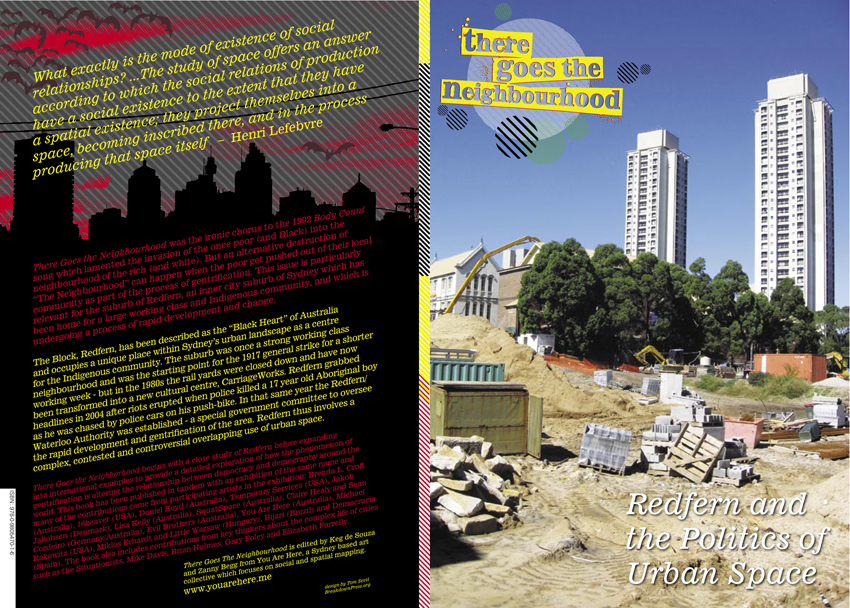Description
The There Goes the Neighbourhood (2009) book was published in tandem with an exhibition of the same name and many of the contributions are from the participating artists; Daniel Boyd, Brenda L. Croft, Lisa Kelly, SquatSpace, Claire Healy and Sean Cordeiro, Evil Brothers, You Are Here (Australia), Michael Rakowitz (USA), Jakob Jakobsen (Denmark), 16beaver (USA), Miklos Erhardt and Little Warsaw (Hungary), Temporary Services (USA), Bijari (Brazil) and (at a satellite venue, we invited Lucas Ihlein to co-ordinate) a re-enactment of Allan Kaprow’s Push and Pull: A Furniture Comedy for Hans Hofmann (with thanks to the Allan Kaprow Estate).
The book also includes contributions from key thinkers about the complex life of cities such as the Situationists, Mike Davis, Brian Holmes, Elizabeth Farrelly and Gary Foley.
You can download a pdf copy here (8MB)
More about the project:
There Goes the Neighbourhood (2009) was an exhibition, residency, discussion and publishing project co-curated with Zanny Begg. The central element of the project was an exploration of the politics of urban space, with a focus on Redfern, Sydney. TGTN was inspired by SquatSpace’s Redfern Waterloo: Tour of Beauty, but extended out to examine the complex life of cities and how the phenomenon of gentrification is altering the relationship between democracy and demography around the world. While urban change itself is not always a bad thing, gentrification often happens at an accelerated rate, out pricing the lower income and marginalized communities from the neighbourhood and dislocating them from their existing connections to urban space. The project brought together artists from Australia and around the world whose work addressed these issues.
“The question of what kind of city we want cannot be divorced from that of what kind of social ties, relationship to nature, lifestyles, technologies and aesthetic values we desire. The right to the city is far more than the individual liberty to access urban resources: it is a right to change ourselves by changing the city. It is, moreover, a common rather than an individual right since this transformation inevitably depends upon the exercise of a collective power to reshape the processes of urbanisation. The freedom to make and remake our cities and ourselves is, I want to argue, one of the most precious yet most neglected of our human rights.”
-David Harvey, The Right to the City
There Goes the Neighbourhood was the ironic chorus to the 1992 Body Count song which lamented the invasion of the once poor (and Black) into the neighbourhood of the rich (and white). But an alternative destruction of “The Neighbourhood” can happen when the poor get pushed out of their local community as part of the process of gentrification. This issue is particularly relevant for the suburb of Redfern, an inner city suburb of Sydney which has been home for a large working class and Indigenous community, and which is undergoing a process of rapid development and change.
The Block, Redfern, has been described as the “Black Heart” of Australia and occupies a unique place within Sydney’s urban landscape as a centre for the Indigenous community. The suburb was once a strong working class neighbourhood and was the starting point for the 1917 general strike for a shorter working week – but in the 1980s the rail yards were closed down and have now been transformed into a new cultural centre, CarriageWorks. Redfern grabbed headlines in 2004 after riots erupted when a 17 year old Aboriginal boy died as he was chased by police cars on his push-bike. In that same year the Redfern/Waterloo Authority was established – a special government committee to oversee the rapid development and gentrification of the area. Redfern thus involves a complex, contested and controversial overlapping use of urban space.
There Goes the Neighbourhood began with a close study of Redfern before expanding into international examples to provide a detailed exploration of how the phenomenon of gentrification is altering the relationship between democracy and demography around the world.
Made possible with the vision and support of Bec Dean, Performance Space
You can view the archived project website here

